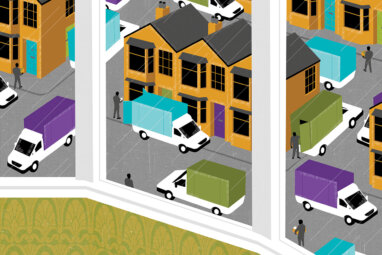Sustainability Through Servicizing
In an increasingly environmentally conscious and cost-conscious world, suppliers can make their business both more sustainable and more profitable by focusing on services that extend the efficiency and value of their products.
As the scientific evidence for environmental degradation becomes harder to discount, enlightened companies have begun embracing the vision of “sustainable development,” defined by the World Commission on Environment and Development as “the ability of current generations to meet their needs without compromising the ability of future generations to meet theirs.”1 But while sustainable development is a desirable goal for society, critics suggest that significant, if not radical, changes in the basic assumptions behind current business models are needed to achieve it.
Contemporary management scholars suggest that sustainability can be addressed by focusing on increased operational efficiency or more environmentally benign products and processes.2 Some argue, however, that while these changes are necessary, they are not sufficient because they do not address consumption levels. Gains in operational efficiency and environment-friendlier technology may even eventually be counteracted by increases in consumption.3 Thus, in order to be a truly sustainable society, developed nations must consume less.4
This is no small challenge to industrial societies, where consumption has traditionally been an end in itself. Yet companies are often in the best position to help customers reduce consumption — even of their own products. By “servicizing,” suppliers may change the focus of their business models from selling products to providing services, thereby turning demand for reduced material use into a strategic opportunity.
This new approach is part of the larger move throughout industry to the provision of services, which, evidence has shown, is linked to higher and more stable profits.5 In addition, some argue that because services are more difficult to imitate than products, they are a source of competitive advantage.6 Thus many traditional manufacturing companies, especially those faced with shrinking markets and increased commoditization of their products, are adopting service provision as a new path toward profits, growth and increased market share.7
Hewlett-Packard Co., for example, has defined “tomorrow’s sustainable business” as one in which it shifts from selling disposable products to selling a range of services around fewer products.8 Another company embracing this approach is Interface Inc., a commercial carpeting company based in Atlanta, Georgia, whose seven-point model of sustainability includes providing “the services their products provide, in lieu of the products themselves.&
References (13)
1. The World Commission on Environment and Development, “Our Common Future” (New York: Oxford University Press, 1987).
2. See, for example, R.S. Marshall and D. Brown, “The Strategy of Sustainability: A Systems Perspective on Environmental Initiatives,” California Management Review 46, no. 1 (fall 2003): 101–126; J. Hall and H. Vredenburg, “The Challenges of Innovating for Sustainable Development,” MIT Sloan Management Review 45, no. 1 (fall 2003): 61–68; F.L. Reinhardt, “Environmental Product Differentiation: Implications for Corporate Strategy,” California Management Review 40, no. 4 (summer 1998): 43–73; and S.L. Hart, “Beyond Greening: Strategies for a Sustainable World,” Harvard Business Review 75 (January/February 1997): 67–76.





Comment (1)
Siswanto Gatot